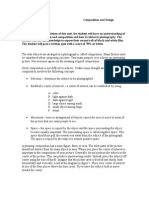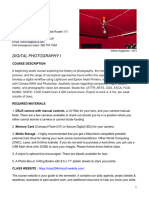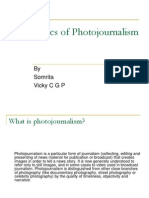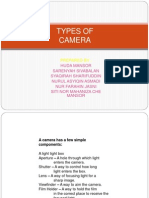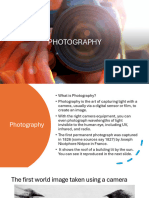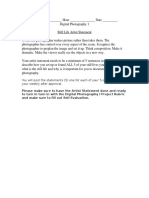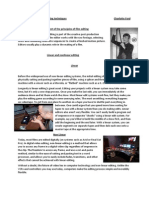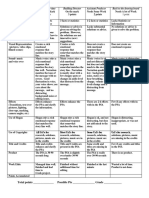Photography Composition: Leading Lines
Photography Composition: Leading Lines
Uploaded by
api-262193618Copyright:
Available Formats
Photography Composition: Leading Lines
Photography Composition: Leading Lines
Uploaded by
api-262193618Original Title
Copyright
Available Formats
Share this document
Did you find this document useful?
Is this content inappropriate?
Copyright:
Available Formats
Photography Composition: Leading Lines
Photography Composition: Leading Lines
Uploaded by
api-262193618Copyright:
Available Formats
Photography Composition
Leading Lines
DIRECTIONS Go take one good photo (inside
school) of each of the following Photography
Composition Rules.
When we look at a photo our eye is naturally
drawn along lines. By thinking about how you
place lines in your composition, you can affect
the way we view the image, pulling us into the
picture, towards the subject, or on a journey
"through" the scene. There are many different
types of line - straight, diagonal, curvy, zigzag,
radial etc - and each can be used to enhance our
photo's composition.
Rule of Thirds
Imagine that your image is divided into 9 equal
segments by 2 vertical and 2 horizontal lines.
The rule of thirds says that you should position
the most important elements in your scene along
these lines, or at the points where they intersect.
Balancing Elements
Placing your main subject off-centre, as with the
rule of thirds, creates a more interesting photo,
but it can leave a void in the scene which can
make it feel empty. You should balance the
"weight" of your subject by including another
object of lesser importance to fill the space.
Symmetry and Patterns
We are surrounded by symmetry and patterns,
both natural and man-made. They can make for
very eye-catching compositions, particularly in
situations where they are not expected.
Viewpoint
Cropping
Before photographing your subject, take time to
think about where you will shoot it from. Our
viewpoint has a massive impact on the
composition of our photo, and as a result it can
greatly affect the message that the shot conveys.
Rather than just shooting from eye level,
consider photographing from high above, down
at ground level, from the side, from the back,
from a long way away, from very close up, and so
on. * Hint Lay down or take a photo from a
high spot.
Often a photo will lack impact because the main
subject is so small it becomes lost among the
clutter of its surroundings. By cropping tight
around the subject you eliminate the background
"noise", ensuring the subject gets the viewer's
undivided attention. * Hint ZOOM IN close
Framing
The world is full of objects which make perfect
natural frames, such as trees, archways and
holes. By placing these around the edge of the
composition you help to isolate the main subject
from the outside world. The result is a more
focused image which draws your eye naturally to
the main point of interest.
You might also like
- 8 2 Composition and Design, DofDocument4 pages8 2 Composition and Design, Dofapi-262193618No ratings yet
- Medical Imaging WebquestDocument8 pagesMedical Imaging Webquestapi-262193618No ratings yet
- The Radio Studio (Chapter 2)Document6 pagesThe Radio Studio (Chapter 2)Lynn NahasNo ratings yet
- Medical Imaging WebquestDocument8 pagesMedical Imaging Webquestapi-262193618No ratings yet
- ThaumatropeDocument4 pagesThaumatropeapi-262193618No ratings yet
- History of Photo PPT AssignmentDocument1 pageHistory of Photo PPT Assignmentapi-262193618No ratings yet
- 07 01-Graphic-FormatsDocument15 pages07 01-Graphic-Formatsapi-262193618No ratings yet
- Psycofcolorpart 2Document23 pagesPsycofcolorpart 2api-262193618No ratings yet
- Photography and Photojournalism PpointDocument12 pagesPhotography and Photojournalism Ppointapi-262193618No ratings yet
- Assignment 1 PowerpointDocument21 pagesAssignment 1 Powerpointapi-262193618No ratings yet
- A Workflow For The Digital DarkroomDocument4 pagesA Workflow For The Digital DarkroomJohn EvansNo ratings yet
- Camera DesignDocument12 pagesCamera DesignSahil TiwariNo ratings yet
- Shutter Speed and ApertureDocument46 pagesShutter Speed and ApertureFweeda MkNo ratings yet
- Chapter 4: Fundamentals of Camerawork and Shot CompositionDocument11 pagesChapter 4: Fundamentals of Camerawork and Shot CompositionBlancaAlvarezPulidoNo ratings yet
- Still Life ProjectDocument1 pageStill Life ProjectmlgiltnerNo ratings yet
- History of Photo WorksheetDocument2 pagesHistory of Photo Worksheetapi-262193618No ratings yet
- Digital Photography Workflow - Fine ArtDocument27 pagesDigital Photography Workflow - Fine ArtSergio DuarteNo ratings yet
- Still Photography Lab (Subject Code: 154) Semester - IiDocument27 pagesStill Photography Lab (Subject Code: 154) Semester - IiNaman jainNo ratings yet
- Lomolovers Vol7Document65 pagesLomolovers Vol7lerdevagarNo ratings yet
- Lesson 1 - JournalismDocument2 pagesLesson 1 - Journalismapi-400778125No ratings yet
- Digital Photo I Sky RevisedDocument4 pagesDigital Photo I Sky RevisedMeredith GiltnerNo ratings yet
- Composition GuidelinesDocument34 pagesComposition GuidelinesNancy PisaniNo ratings yet
- Handout - Nostalgia: 50 ISODocument3 pagesHandout - Nostalgia: 50 ISOjcecilNo ratings yet
- FinalpowerpointDocument16 pagesFinalpowerpointapi-293793567No ratings yet
- Imovie '09 Step Guide: Apple Professional Development 1Document14 pagesImovie '09 Step Guide: Apple Professional Development 1Lena ChandraNo ratings yet
- Claymation AssignmentDocument7 pagesClaymation AssignmentGrayson AllensworthNo ratings yet
- Carma Shots and Angles Worksheet 2Document1 pageCarma Shots and Angles Worksheet 2api-380214067No ratings yet
- 2nd Photoshoot Plan-ShadowsDocument1 page2nd Photoshoot Plan-Shadowsapi-265588212No ratings yet
- Lesson Plan 1 PhotographyDocument3 pagesLesson Plan 1 Photographyapi-238908798No ratings yet
- Spring 2024 Crea204 SyllabusDocument5 pagesSpring 2024 Crea204 Syllabusapi-687869953No ratings yet
- The Ethics of PhotojournalismDocument31 pagesThe Ethics of PhotojournalismMichaelJohnLerumNo ratings yet
- Types of CameraDocument16 pagesTypes of CameraOsman Gumanti Ahmad AlbabNo ratings yet
- Richard Benson Modern PhotographyDocument30 pagesRichard Benson Modern PhotographyKingston KohNo ratings yet
- PhotographyDocument94 pagesPhotographystephenawino11No ratings yet
- Introduction To PhotographyDocument21 pagesIntroduction To PhotographyRavi Prakash RaoNo ratings yet
- Lesson Plan DigitalDocument3 pagesLesson Plan Digitalapi-316401614No ratings yet
- Camera Basics-Part 1Document31 pagesCamera Basics-Part 1api-424711236No ratings yet
- Photo 1 Midterm Review 2017Document417 pagesPhoto 1 Midterm Review 2017caro sturgesNo ratings yet
- The New Piezography: Users ManualDocument73 pagesThe New Piezography: Users ManualKevin SharpNo ratings yet
- Camera TypesDocument5 pagesCamera Typesapi-262193618No ratings yet
- Canon EF S 18 200mm F 3.5 5.6 IS LensDocument0 pagesCanon EF S 18 200mm F 3.5 5.6 IS LensAldo Amilcar Maguiña AgüeroNo ratings yet
- Constructing The PropDocument22 pagesConstructing The PropjcecilNo ratings yet
- PointofviewphotographyDocument8 pagesPointofviewphotographyapi-420350912No ratings yet
- News Brief RubricDocument2 pagesNews Brief Rubricapi-438611508No ratings yet
- Zone System DIYDocument8 pagesZone System DIYBenjamin Cortés LyonNo ratings yet
- Still Life Artist 2016Document1 pageStill Life Artist 2016mlgiltnerNo ratings yet
- Combined VE SLMDocument150 pagesCombined VE SLMAnzar khanNo ratings yet
- Landscape PhotographyDocument6 pagesLandscape Photographyapi-545222989No ratings yet
- Media Unit 16 LeafletDocument2 pagesMedia Unit 16 LeafletAkil Tj YearwoodNo ratings yet
- History of PhotographyDocument11 pagesHistory of PhotographyjanishaNo ratings yet
- Development of The Principles of EditingDocument5 pagesDevelopment of The Principles of Editingapi-264459464No ratings yet
- History of MoviesDocument15 pagesHistory of Moviesapi-262193618No ratings yet
- Digital Cameras /digicams: Name - Prabhat Pandey Class - Xii-A Roll No - 1022 Subject - PhotographyDocument11 pagesDigital Cameras /digicams: Name - Prabhat Pandey Class - Xii-A Roll No - 1022 Subject - Photographyprabhat100% (1)
- Web History of Photo 2014Document150 pagesWeb History of Photo 2014caro sturgesNo ratings yet
- Instruction Manual Mount Change Instructions Zeiss Cinema Zoom LensesDocument24 pagesInstruction Manual Mount Change Instructions Zeiss Cinema Zoom LensesdimodimoNo ratings yet
- How To Use DSLR CameraDocument12 pagesHow To Use DSLR CameraatikahNo ratings yet
- Time-Lapse Photography Skillshare Course Outline and Quick PrintsDocument6 pagesTime-Lapse Photography Skillshare Course Outline and Quick PrintsRyan Chylinski100% (1)
- Kyle K’S Night & Light Photography: Photography at the Next LevelFrom EverandKyle K’S Night & Light Photography: Photography at the Next LevelNo ratings yet
- How to Succeed in Commercial Photography: Insights from a Leading ConsultantFrom EverandHow to Succeed in Commercial Photography: Insights from a Leading ConsultantNo ratings yet
- History of Photo WorksheetDocument2 pagesHistory of Photo Worksheetapi-262193618No ratings yet
- Logline Trailer Worksheet Video Media Technology Unit Film StudyDocument2 pagesLogline Trailer Worksheet Video Media Technology Unit Film Studyapi-262193618No ratings yet
- Eye Function NotesDocument3 pagesEye Function Notesapi-262193618No ratings yet
- Assignment 1 PowerpointDocument21 pagesAssignment 1 Powerpointapi-262193618No ratings yet
- History of MoviesDocument15 pagesHistory of Moviesapi-262193618No ratings yet
- Television in The United States - Britannica Online EncyclopediaDocument58 pagesTelevision in The United States - Britannica Online Encyclopediaapi-262193618No ratings yet
- Video ProjectDocument2 pagesVideo Projectapi-262193618No ratings yet
- The Human Eye Powerpoint NotesDocument22 pagesThe Human Eye Powerpoint Notesapi-262193618No ratings yet
- Camera PartsDocument3 pagesCamera Partsapi-262193618No ratings yet
- Master Photographers 50s 60s 70sDocument29 pagesMaster Photographers 50s 60s 70sapi-262193618No ratings yet
- Note-Taking Guide: Adobe Visual Design 3.00 Understanding Adobe PhotoshopDocument4 pagesNote-Taking Guide: Adobe Visual Design 3.00 Understanding Adobe Photoshopapi-262193618No ratings yet
- Famous Photographers RubricDocument2 pagesFamous Photographers Rubricapi-262193618No ratings yet
- Psa RubricDocument1 pagePsa Rubricapi-262193618No ratings yet
- 09 01-Design-Principles-Font-TypefaceDocument20 pages09 01-Design-Principles-Font-Typefaceapi-262193618No ratings yet
- DM 10101Document6 pagesDM 10101api-262193618No ratings yet
- DM 10201Document4 pagesDM 10201api-262193618No ratings yet
- 9 01-Design-PrinciplesDocument19 pages9 01-Design-Principlesapi-262193618No ratings yet
